Elk Eber
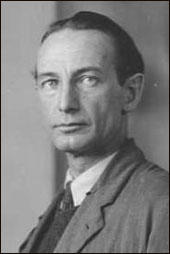
Elk Eber was born in Germany on 18th April, 1892. After graduating from high school he went to the Ludwig Maximilians University in Munich as a student of art history before switching to the Royal School of Applied Arts in 1911. He fought for the German Army during the First World War. He returned with a hearing loss and devoted himself to his artistic work. (1)
Eber joined the right-wing Freikorps. Led by Colonel Franz Epp, he entered Munich on 1st May, 1919. (2) Over the next two days they easily defeated the Red Guards. Allan Mitchell, the author of Revolution in Bavaria (1965), pointed out: "Resistance was quickly and ruthlessly broken. Men found carrying guns were shot without trial and often without question. The irresponsible brutality of the Freikorps continued sporadically over the next few days as political prisoners were taken, beaten and sometimes executed." An estimated 700 men and women were captured and executed." It is estimated that Epp's men killed over 600 communists and socialists over the next few weeks. (3)
Eber joined the Nazi Party and in 1921 the Sturmabteilung (Storm Detachment). The SA was assigned the task of winning the battle of the streets against the Communists. The SA wore grey jackets, brown shirts (khaki shirts originally intended for soldiers in Africa but purchased in bulk from the German Army by the Nazi Party), swastika armbands, ski-caps, knee-breeches, thick woolen socks and combat boots. Accompanied by bands of musicians and carrying swastika flags, they would parade through the streets of Munich. At the end of the march Adolf Hitler would make one of his passionate speeches that encouraged his supporters to carry out acts of violence against Jews and his left-wing political opponents. (4)
On 8th November, 1923, the Bavarian government held a meeting of about 3,000 officials. While Gustav von Kahr, the prime minister of Bavaria was making a speech, Adolf Hitler and 600 armed SA men, including Elk Eber, entered the building. According to Ernst Hanfstaengel: "Hitler began to plough his way towards the platform and the rest of us surged forward behind him. Tables overturned with their jugs of beer. On the way we passed a major named Mucksel, one of the heads of the intelligence section at Army headquarters, who started to draw his pistol as soon as he saw Hitler approach, but the bodyguard had covered him with theirs and there was no shooting. Hitler clambered on a chair and fired a round at the ceiling." Hitler then told the audience: "The national revolution has broken out! The hall is filled with 600 armed men. No one is allowed to leave. The Bavarian government and the government at Berlin are hereby deposed. A new government will be formed at once. The barracks of the Reichswehr and the police barracks are occupied. Both have rallied to the swastika!" (5)
Leaving Hermann Göring and the SA to guard the 3,000 officials, Hitler took Gustav von Kahr, Otto von Lossow, the commander of the Bavarian Army and Hans von Seisser, the commandant of the Bavarian State Police into an adjoining room. Hitler told the men that he was to be the new leader of Germany and offered them posts in his new government. Aware that this would be an act of high treason, the three men were initially reluctant to agree to this offer. Adolf Hitler was furious and threatened to shoot them and then commit suicide: "I have three bullets for you, gentlemen, and one for me!" After this the three men agreed to become ministers of the government. (6)
The following day Adolf Hitler, Hermann Kriebel, Eric Ludendorff, Julius Steicher, Hermann Göring, Max Scheubner-Richter, Walter Hewell, Wilhelm Brückner and 3,000 armed supporters of the Nazi Party marched through Munich in an attempt to join up with Röhm's forces at the War Ministry. At Odensplatz they found the road blocked by the Munich police. One observer said that Hitler fired the first shot with his revolver. Another witness said it was Steicher while others claimed the police fired into the ground in front of the marchers. (7)
William L. Shirer has argued: "At any rate a shot was fired and in the next instant a volley of shots rang out from both sides, spelling in that instant the doom of Hitler's hopes. Scheubner-Richter fell, mortally wounded. Göring went down with a serious wound in his thigh. Within sixty seconds the firing stopped, but the street was already littered with fallen bodies - sixteen Nazis and three police dead or dying, many more wounded and the rest, including Hitler, clutching the pavement to save their lives." (8)
Most of the leaders were sent to prison but Elk Eber remained free and decided to use his artistic ability to support the fascist cause. In 1931 he began providing drawings for Nazi newspapers such as the Völkische Beobachter. (9) After Hitler obtained power in 1933 Eber joined forces with other artists such as Hermann Otto Hoyer, Anton Hackenbroich and Fritz Erler who "glorified Germany's war efforts and the heroic self-sacrifice of those" during the First World War. (10)
It was decided to hold a Great German Art Exhibition in Munich. Adolf Ziegler, signed the announcement for the competition. "All German artists in the Reich and abroad" were invited to participate. The only requirement for entering the competition was German nationality or "race". After extending the deadline for submissions, 15,000 works of art were sent in, and of these about 900 were exhibited. According to official records, the exhibition had 600,000 visitors. (11) Hubert Wilm, a pro-Nazi artist, explained what they were trying to achieve: “Representation of the perfect beauty of a race steeled in battle and sport, inspired not by antiquity or classicism but by the pulsing life of our present-day events”. (12)
In 1937 Eber showed The Last Grenade at the Great German Exhibition. The following year he exhibited his most famous painting, This Was the SA. " Eber's composition who was the SA was exhibited in Munich showing a march of a SA troop under a swastika banner, a man in the foreground with his head bandaged, and curious onlookers on the side, among them an admiring young boy - in what was most certainly to be a Berlin Communist stronghold in the last republic." (13) Hitler was so impressed with the painting he purchased it for 12,000 RM. (14) Over the next few years a total of 16 of his oil paintings were shown at the annual Great German Art Exhibition. (15)
On the outbreak of the Second World War in 1939 Luitpold Adam, who served as a war artist in the First World War, headed up Hitler's official war art program. It eventually numbered some 80 soldier-artists and included Elk Eber, Fritz Erler, Franz Eichhorst, Wolf Willrich and Rudolf Hengstenberg."There works were described in the government-controlled art press as derived from the artists' immediate experience of war, though none, predictably, drew attention to the actual blood and death of the battlefront and... instead glorified Germany's war effort and the heroic self-sacrifice of those who served." (16)
Elk Eber died of peritoneal tuberculosis on 12th August, 1941.
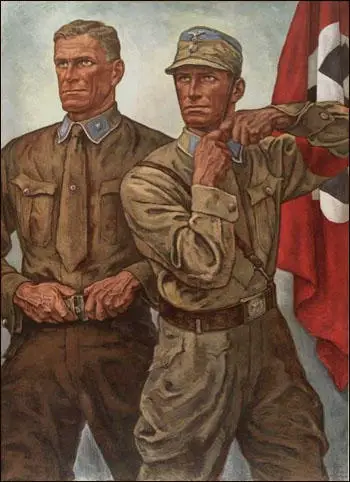
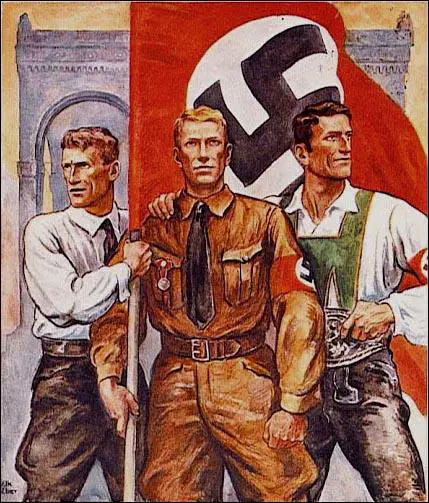
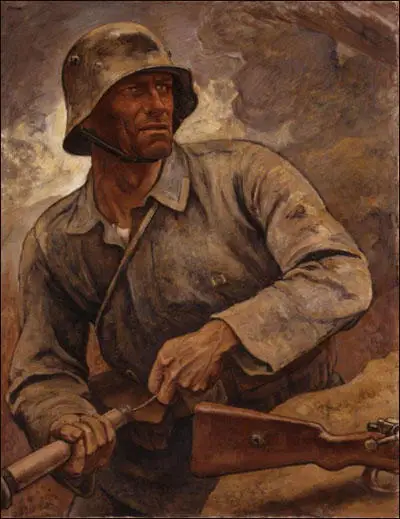
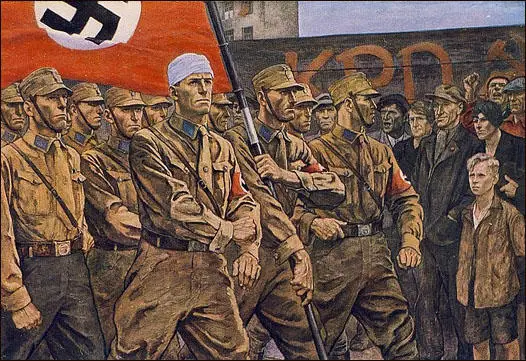
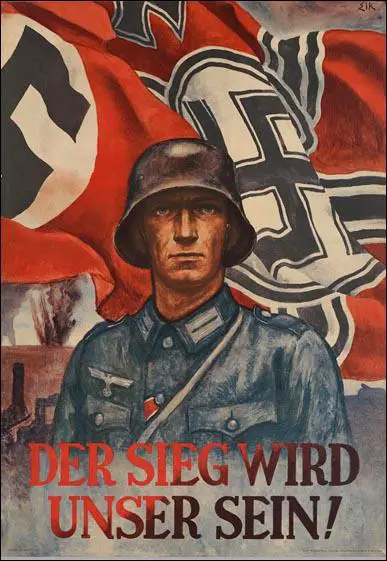
Primary Sources
(1) Galleria Thule Italia, Elk Eber (11th March, 2009)
Eber volunteered for the front as an infantryman simple despite having been requested by the Bavarian Ministry of War as an artist to depict scenes of war. During the service at the front, as a result of the explosion of a grenade, suffers a serious injury in his right ear with hearing loss and a scar under his eye. In this period he began an intense pictorial drawing portraits of fellow soldiers and war scenes with watercolors.On 28 April 1919 Eber is among the first to join the Freikorps... On 1 May 1919 with other 270 comrades in command of Ritter von Epp moved to Monaco to take part in the fighting against the newly proclaimed Republic. Draw several posters and notices of enlistment for 'Oberland that will be disseminated as postcards. The 9 November 1923 participated in the historic march towards the Feldherrnhalle of Monaco where Hitler himself miraculously saved and 16 militants are killed:
(2) Michael H. Kater, Culture in Nazi Germany (2019)
As a creator of portraitures of small Nazi scenarios Elk Eber stood out. The World War I veteran and participant in the 1923 Hitler Putsch began his Nazi artistic career in the early 1920s as a draftsman for the Völkische Beobachter and creator of political posters until 1933. Until the July 1937 Munich signature exhibition, where his famous painting The Last Hand Grenade was on display, he had established himself as a pictorial chronicler of exceptionally committed Nazis and the broader Volksgemeinschaft. In 1938, Eber's composition who was the SA was exhibited in Munich (Hitler then bought it) showing a march of a SA troop under a swastika banner, a man in the foreground with his head bandaged, and curious onlookers on the side, among them an admiring young boy - in what was most certainly to be a Berlin Communist stronghold in the last republic. Whereas Eber was fond of illustrating conflict and Nazi martyrdom - he died in 1941, aged forty-nine, after having sketched soldiers and Jews at forced labor during the Polish campaign - these artists dedicated themselves to more prosaic Nazi social topics.
(3) Barbara McCloskey, Artists of World War II (2005)
Luitpold Adam, who served as a war artist in World War I, headed up Hitler's official war art program after 1939. Adam's Division of Visual Arts eventually numbered some 80 soldier-artists, whose lives and art have yet to receive extended treatment in the art historical literature on this period. There works were described in the government-controlled art press as derived from the artists' immediate experience of war, though none, predictably, drew attention to the actual blood and death of the battlefront. Paintings and drawings by Elk Eber, Fritz Erler, Franz Eichhorst, Wolf Willrich, Rudolf Hengstenberg, and other soldier-artists instead glorified Germany's war effort and the heroic self-sacrifice of those who served.
